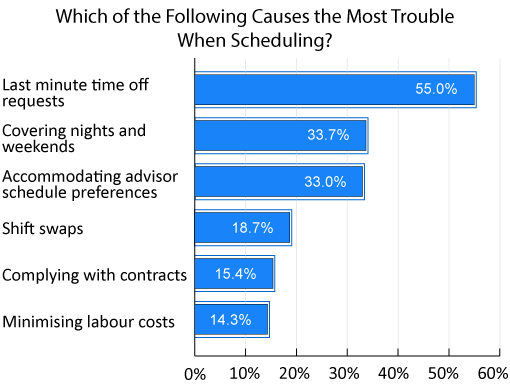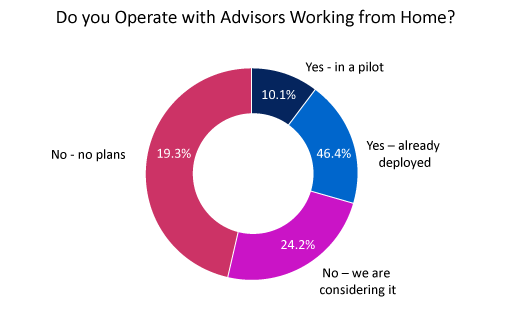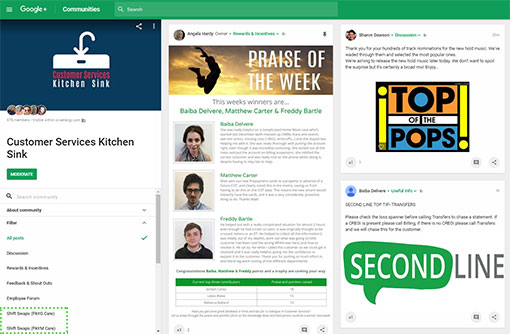We investigate how contact centres can go about improving advisor satisfaction by making changes to their scheduling practices.
Think of Schedule Dissatisfaction as an Opportunity for Employee Engagement
The principal reason that schedule dissatisfaction exists is because management see it as an efficiency challenge instead of an employee engagement opportunity, according to Dougie Cameron, Director of addzest consulting.
Treating schedules as an employee engagement opportunity will help you to retain your people and reduce attrition costs.
Dougie Cameron
Dougie says: “Treating schedules as an employee engagement opportunity will help you to retain your people and reduce attrition costs. Unexplained absences will also be reduced, removing short-term problems with service level.”
“If you can create schedules that better fit your advisors’ lifestyles, they’re going to be happier and customers are going to be served by better, more experienced advisors, which all leads to increased advocacy and improved profitability.”
But how can you go about changing this efficiency-based mindset and receive all of these benefits?
Change Your Organisational Mindset
For years and even decades, contact centres have been “plugging the gaps” when it comes to scheduling. Now is the time to step back and look into what other forward-thinking companies are doing.
As Dougie says: “For many contact centres, creating schedules is effectively like playing a game of human Tetris, fitting people into gaps of demand that they can satisfy as efficiently as possible.”
“However, the downside of that is that it is humans that you are playing Tetris with, and people don’t live their lives in blocks of time that are a perfect fit for an efficient contact centre schedule. That’s where schedule dissatisfaction comes in.”

Our 2017 research found that many contact centres struggle to accommodate advisor shift preferences
Your contact centre may have a great atmosphere, pay well and run an otherwise efficient operation, but if another job will provide an advisor with an hour in the evening to pick their children up from school, that will likely be their preferred choice.
So, now’s the time to start looking into flexibility levers that will enable you to create shifts that fit better around your advisors’ busy lives.
Design Shifts to Suit Lifestyles
If you can’t create a schedule that fits in and around an advisor’s everyday life, then short-term absences will always be a fact of life. This creates unplanned gaps in the schedule, which are the worst ones to have.
Contact centres that employ rotational shifts often face this problem, because nobody has a rotational life, as Dougie points out.
Don’t Do Rotational Shifts
Dougie says: “Unless there is employee demand for it, don’t do rotating shifts, because who has a lifestyle where they’re only available in the mornings one week and then only in the afternoon the next? You will just create problems for yourself.”
Don’t do rotating shifts, because who has a lifestyle where they’re only available in the mornings one week and then only in the afternoon the next? You will just create problems for yourself.
“It is nearly always better to offer fixed shifts with some added flexibility than rotating shifts that are fixed – just ask your employees.”
“We spend so much time researching what our customers want. Those customers then phone in to speak to one of our employees as a first line of contact, so we should do just as much research on the employee side of that equation.”
For ten more ideas on how to improve your contact centre schedules, read this article on Workforce Optimisation: 10 Ways to Improve Your Contact Centre Schedules.
What Time Do the Buses Run?
“A lot of planners will miss really obvious things like: how far is from the centre the local bus stop? And what time do the buses run? Are your shifts fitting in so that people can comfortably finish at the contact centre, walk to the station and catch the bus?
“If you’re not considering the basic hygiene factors in your schedule, you already have service level problems, because people have to get on with their lives outside of work. The best schedules are designed from a clear people strategy and are empathetic. So, think of everything, research the people who are going to work for you and what’s important to them, and build the schedule according to that, instead of starting from the small gaps in demand.”
By researching the ideal hours that advisors would like to work, you can design shifts to best suit their preferences, and while you may think that there will then be no one to work weekends and night-shifts, there are people out there…
Make Smart Recruitment Decisions
According to Dougie, there are demographics for every fixed shift. So, it can be good to recruit people from other professions, such as social care, who are used to working strange hours and are feeling undervalued in their current role.
Permanent Night Shifts Suit Some People’s Lifestyles
Another example that Dougie gives is “a permanent night-shift that had an almost 0% attrition rate, and the reason for it was that we recruited people whose lifestyle suited that. They didn’t like waking up early in the morning, and sleeping during the day wasn’t an issue for them.”
Don’t design shifts for efficiency, design shifts so that people want to work them and then calculate the efficiency part afterwards.
“There are plenty of people out there with different motivations and different lifestyles. You just need to understand what time you are trying to fill and how to find the best people to fit it, and keep them!”
“So remember, don’t design shifts for efficiency, design shifts so that people want to work them and then calculate the efficiency part afterwards. Spreadsheet efficiency is often fool’s gold when put live into a busy contact centre.”
Other contact centres will offer existing advisors to switch to a new shift pattern before they recruit for it, instead of choosing to make changes to recruitment and staffing practices. However, even this has its flaws.
As Dougie says: “If there are a lot of people wanting to swap shift patterns, it looks like you’ve got a real imbalance in the shift designs that you have created. You’ve created a really attractive one, but now you have to recruit to your really unattractive one. So, you end up just shifting the problem.”
Instead, design fixed shifts around lifestyles, target recruits with these lifestyles and then look to add flexibility levers. These levers can include homeworking, flexi-shifts and shift-swapping, as discussed below.
Homeworking Can Be Valuable
One flexibility lever, which may seem like a big step to take, is homeworking – an option that is proving popular amongst new operations, as advisors are less limited by travel and things of that nature. It also makes things easier when drafting advisors in to cover small gaps in the schedule.

Dougie Cameron
Dougie says: “Some contact centres, if they have a one-hour gap in the day, they’ll try and fix that by offering a one-hour shift. That one extra hour may involve having to get the bus, arrange child care and so on.”
“However, logging in from home might actually be ideal for that person, as they can fit it around everything else they’re doing in the day.”
Another benefit is that you’re attracting a new demographic of people, widening the pool of potential advisors that you may want to recruit.
Dougie says: “Homeworking contact centres tend to have the most eclectic background of advisors, as they can fit a working from home schedule around their busy lifestyles, while they couldn’t otherwise find jobs with that benefit. Some of the best performance results that I have seen have come from homeworking teams.”

According to our research, almost 30% of contact centres either have homeworking in pilot or have already deployed it
Allow 12 Flexi-Shifts a Year
The Vax contact centre in Droitwich has brought in an interesting flexibility lever such that if an advisor is running late, they can defer their start time by up to 90 minutes, adding the time to end of their shift. Advisors are allowed to do this 12 times a year.
By introducing this initiative, Vax were able to reduce absenteeism and lateness by a significant margin, while they also reported a great improvement in their engagement levels.
Anything that gives the advisor a degree of control over the schedule will make the advisor happier.
Discussing this idea, Dougie says: “Anything that gives the advisor a degree of control over the schedule will make the advisor happier. If you can accept a little bit of inefficiency with occasional flexi-days, you need to think about how you can get it to work for you.”
“Can you bring in a little e-learning? Or more coaching that ultimately benefits the customer when an advisor stays behind to account for the lateness? Don’t just spread the contacts out across a bigger team; answering calls in a couple of seconds instead of 20 won’t provide you with the same long-term benefits.”
Make Shift-Swapping Easy
Shift-swaps can be a great way of adding flexibility to the advisor schedule. But many contact centres are wary of offering them, with managers thinking that they will have to be the “middle-man”, which could end up taking up a lot of their time and effort – especially in a large contact centre.
However, there are some steps to get around this. Take OVO Energy’s contact centre in Bristol, for instance. They use a Google Community page, which all advisors have access to and can “post” on.
All posts can be filtered by topic and placed into categories, allowing OVO to have “shift-swap” categories for different skill sets. This means that advisors can easily find colleagues who may be interested in swapping shifts, while cutting out the middle man.

Here’s what OVO’s community page looks like, with a section designated specifically for shift-swapping.
Another option is to use a Workforce Management (WFM) system with a sophisticated advisor interface – something Dougie is an advocate for.
Dougie says: “If I were going through requirement analysis for a new WFM system, the advisor interface would be key. How can I give advisors flexibility? How can I make the schedules accessible from smartphones? How can I make the advisor feel like they’re in charge of their working life?”
“Ask the vendor how easy it will be for advisors to shift-swap, always keeping the advisor experience in mind, while the WFM system should also be able to ensure that the right skills are being swapped for the right skills.”
For more on how to get shift-swapping right, read our article: The Trials and Tribulations of Shift-Swaps
Be Wary of Banked Hours
One simple way to add flexibility to the schedule is to allow advisors to leave early when contact volumes are lower than expected, with the promise that they make up the time later in the year.
While having this choice may suit some advisors, Dougie warns that this can be tricky as he knows of situations where the advisor owes more hours than they can ever physically give back.
Dougie says: “If you’re looking to bring in a banked-hours scheme, you have to do it with caps in place so that advisors can only carry a certain number of hours at a time.”
If you’re looking to bring in a banked-hours scheme, you have to do it with caps in place so that advisors can only carry a certain number of hours at a time.
“Banked hours can work well, but it can be a risky initiative if you are not prepared to monitor it closely, as we all know how contact volumes can change from second to second.”
“If you did send people home and you are under-resourced for the next quarter of an hour, for example, it can take you two or three hours to get a service level back.”
Another worry could be that some advisors end up resenting that they are working hours that they could have before been paid overtime for, reducing their overall earnings.
With this in mind, make sure you have a comprehensive strategy in place before implementing annualised hours. If you do so, you can help to enhance advisor advocacy and lower attrition, while lowering the costs of temporary resources.
Find out how to best utilise such an initiative by reading our article: Six Steps to Implement Annualised Hours in the Contact Centre
In Summary
To improve schedule satisfaction, first look at staffing as an engagement opportunity as opposed to something that is there for efficiency purposes.
Spread this message and get support for a change in scheduling systems, which may be hard to do as many people in contact centres like to create efficiency measures, as it’s easy to create metrics around them.
But focus on the opportunity to improve engagement while reducing the absenteeism and attrition – that’s the key message.
Once you have buy-in, talk to advisors before designing fixed shifts that suit their lifestyles as well as others, who can be brought into the contact centre from other fields, such as social care.
Then, with these fixed shifts, look for ways to add flexibility, considering the potential positive impact of homeworking, flexi-shifts and shift-swaps.
For more on contact centre scheduling, read our articles:
- How to Work Out How Many Staff You Need in a Contact Centre
- 10 Things You Must Know to Calculate How Many Contact Centre Advisors You Need
- What Is an Erlang Calculator?
Author: Robyn Coppell
Published On: 9th Jan 2019 - Last modified: 13th Aug 2025
Read more about - Workforce Planning, Dougie Cameron, Editor's Picks, Employee Engagement, Morale, Scheduling, Staffing, Team Management, Workforce Management (WFM), Workforce Planning











































